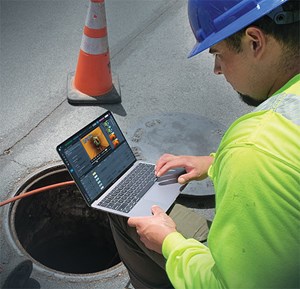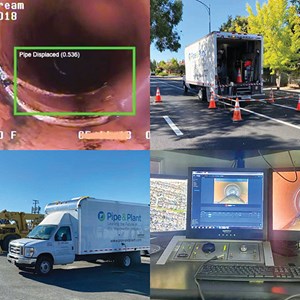October 2022 Vol. 77 No. 10
Features
Artificial Intelligence Speeds Houston’s Sewer Inspections Under Sharp Eye of EPA
Jeff Awalt | Executive Editor
(UC) — In Steven Spielberg’s 2001 film, “A.I. Artificial Intelligence,” the eponymous technology appears as an ultrarealistic cyborg named David, who dreams of becoming a real boy. His backstory is earthier than moviegoers might have guessed.
In the real-life prequel, now playing in the sprawling sanitary sewers of Houston, David’s ancestral code is proving to be an essential tool in the city’s race to comply with a demanding federal consent decree.
Working with California-based Sewer AI, through engineering and consulting firm HR Green, Houston has made artificial intelligence a core piece of its inspection and repair workflow since 2021 – the same year a federal judge approved its agreement with the U.S. Environmental Protection Agency (EPA) and its co-plaintiffs, including the state commission that administers the National Pollutant Discharge Elimination System program under the federal Clean Water Act (CWA).
The final decree – a product of more than six years of negotiations between the city and the EPA – aims to halt the sanitary sewage overflows (SSOs) that have often overwhelmed flood-prone Houston.
At a projected cost of $2 billion over 15 years, it sets an aggressive schedule for cleaning and repairing sewer pipes, treatment plants and lift stations that span the 637-square-mile city. The sheer scale of that challenge has led city water officials to modernize not only the infrastructure, but their technology for managing it, as well.
“Using this (artificial intelligence) technology definitely has increased the efficiency of our inspection process, which used to be done manually,” Houston Water Managing Engineer Fazle Rabbi, told Underground Construction.
“The results we see are very positive,” he added. “And the more and more we use it, we should be able to enhance the accuracy of this technology.”
Rabbi, whose experience has made him a sought-after speaker by industry professionals looking to modernize their own wastewater systems, is quick to point out that that Houston’s use of A.I. is just one element in a years-long digital transformation and cannot take place in isolation.
More than a tool to meet the ambitious timeline of a consent decree, Rabbi emphasizes that one of the greatest advantages of automating a sewer inspection process is the additional time it provides for the planning and management of cost-efficient additions and repairs.
“Our (inspection and repair) volume is very high, and we need to get the conditions known as early as possible so we can plan as proactively as possible,” he said. “That is one way to increase efficiency, to audit most effectively, so we don’t hurry repairs.”
The challenge
The city of Houston covers a vast swath of flat, coastal plains dotted with swamps and marshes, crisscrossed by four major bayous. It sits only 50 feet above sea level just 50 miles from the Gulf of Mexico, which regularly pummels the city with tropical weather systems that can overwhelm infrastructure.
Runoff from heavy rains has only worsened with constantly expanding greenfield development throughout a metropolitan area that is now home to more than 7 million people. Its history is rife with deadly and increasingly costly weather events, including Tropical Storm Allison, which stalled over the city in 2001 and caused flooding that killed more than 20 people, damaged or destroyed tens of thousands of homes and caused an estimated $5 billion in damage.
It fared even worse in 2017 when Hurricane Harvey slammed ashore as a Category 4 storm farther south and bounced along the coast before moving inland and stalling for days over the Houston region with wave after wave of torrential rains. It dumped more than 30 record-breaking inches in parts of Houston and more than 60 in nearby Nederland, causing devastating floods that took weeks to fully subside. Around 100 deaths and $125 billion in damage were attributed to the storm,
But it didn’t take such major events to cause flooding and overwhelm the city’s existing wastewater lines and underpowered infrastructure, and the city’s work to address those problems started long before the start of negotiations with EPA officials, who sought to work out a deal rather than sue the city for CWA violations.
In fact, Houston had been trying for years to update and expand water systems on pace with its population growth and had already spent nearly $3 billion in upgrades and renewals to millions of feet of pipes and infrastructure prior to the 2021 decree.
For all its complexity, the stated objective of the 137-page final consent decree is simply to take all measures agreed upon to comply with the CWA with the goal of eliminating SSOs. The decree sets guidelines and timelines to fix aging wastewater lines and upgrade infrastructure with a priority focus on areas that have a history of recurring, high-volume SSOs.
It requires that the city must repair or replace about 150 miles of its gravity-driven sewer pipes per year and at least 5 percent of the approximately 400 lift stations that move sewage across its flat topography.
Further, it mandates that Houston proactively clean at least 275 miles of small pipes in areas with known spill problems and, within 10 years, address overflows in specific areas known for having significant releases during heavy rains.
Going digital
The pace and scale of Houston’s challenge is so daunting that Rabbi and others in its water department were early to recognize the essential role that technology must play in achieving their objectives.
Houston’s wastewater infrastructure is staggering, with more than 6,000 miles of pipes, 133,000 manholes, 381 lift stations and 39 treatment plants serving a population of more than 2.2 million, along with some smaller area municipalities that contract with the city for treatment services
Rabbi, who first joined the city’s Public Works department in 2005, said his group has been working to improve Houston’s wastewater systems since he rejoined the group in 2012 after a four-year consulting hiatus.
“It’s not that we just started as part of the consent decree. We were negotiating the consent decree over many years, and we knew that we had to be more efficient,” Rabbi said, describing the lead-up to adding A.I. in its workflow.
“So, it’s not new for Houston to be proactive in evaluating and adopting cutting-edge technologies whenever something new is available,” he added. “This is a continuation of the culture our city has.”
One of the early, ongoing initiatives has been the installation of digital monitoring sensors. More than 300 of them had been installed underground before the consent decree was signed, and Rabbi said the city negotiated to increase that number ten-fold under the deal. More than 600 have been installed to date, he said.
Houston has long embraced the use of robotic CCTV inspections of its sewer lines operated by above-ground specialists, along with other technologies to better manage its systems and help replace a retiring workforce with digital-native millennials.
“Everything has to be digital, and we are always exploring new imaging technologies that may help us improve and manage our wastewater systems better,” Rabbi said.
One area in which his department has been on the leading edge of inspection technology is the early adoption of GoPro 360-degree cameras in a quest to inspect some 10,000 manholes per year.
Using this method, small crews can capture data using a sub-$500 camera that would otherwise require sophisticated manhole scanning systems at a capital investment of around $150,000, said Eric Sullivan, Sewer AI’s director of business development.
“They can attach the GoPro to a pole and, with the right lights, capture data that we think is actually superior to what those other rigs can offer,” said Sullivan, a 10-year veteran NASSCO trainer. “It’s all about the software that one would use to process this data.”
Employing two fisheye lenses that slightly overlap each other’s field of view, the GoPro cameras capture millions of pixels of video data that Sewer AI’s photogrammetry software processes to produce a full, geometric 3D model of the structure.
Rise of A.I.
Houston’s growth, terrain and weather create unique challenges for the city’s wastewater systems, but its aging water infrastructure is a problem that plagues cities throughout the United States, where the average U.S. water-network pipe is 45 years old and many cast-iron pipes are more than a century old, according to a 2021 report by the American Society of Civil Engineers (ASCE).
Artificial intelligence technologies moved into the wastewater management space to help system owners address the challenges of both aging infrastructure and the loss of experience with an aging workforce.
Traditional CCTV inspections require that the individual who operates the robot also be an expert in how sewers deteriorate and how to do condition assessment. It can be hard to find people who are knowledgeable, consistent and know how to operate the equipment.
Sewer AI, Sullivan said, was formed to provide solutions to reduce the cost and increase the speed and data quality of inspections and provide cloud-based tools to collaborate in ways that weren’t possible before.
“Since the dawn of the CCTV equipment, the most common workflow is that the operators are driving the camera in the pipe, and when they see something in the live video, they’re going to stop the camera and type something into code it,” Sullivan said, citing a German study of CCTV operators that found about 20 percent of structural defects don’t get coded using a manual method.
“Our point at Sewer AI is that the operator should never be taking their hands off the camera controls. They should never be wasting time figuring out if it’s a crack circumferential or a fracture multiple,” he said. “They should just make sure it got on the video, and then they should get that video to the experts who use AI.”
When it does go to the experts, their artificial intelligence systems are looking at every pixel in every frame of every video. And each of the different AI tools is designed to look for distinct types of conditions in a way that Sullivan says is “much more rigorous than you would ever get from people manually watching or trying to annotate at that level.”
It’s also dramatically faster, a key benefit for Houston’s aim of inspecting more than 5 million linear feet of pipe per year. And, as Rabbi pointed out, one of the biggest advantages to using artificial intelligence technology is that it continues to learn and improve the more data it processes.
“The A.I. tools that we use are processing about 25,000 to 50,000 feet per hour, and we can run multiple inferences in parallel,” Sullivan said. “So technically speaking, there’s very little limitation to it.”
FOR MORE INFORMATION:
Sewer AI: (866) 631-1323, sewerai.com
HR Green: (713) 965-9996, hrgreen.com






Comments